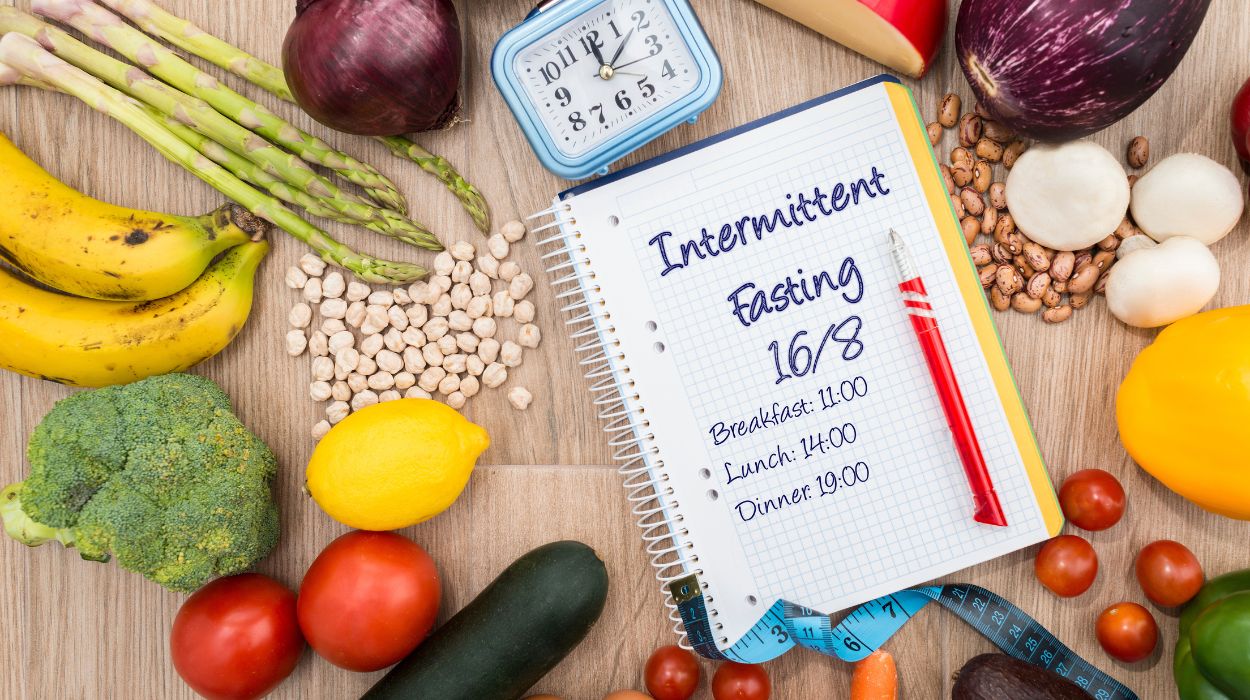 Expert's opinion
Expert's opinion
Expert's opinion
The article is a subjective view on this topic written by writers specializing in medical writing.
It may reflect on a personal journey surrounding struggles with an illness or medical condition, involve product comparisons, diet considerations, or other health-related opinions.
Although the view is entirely that of the writer, it is based on academic experiences and scientific research they have conducted; it is fact-checked by a team of degreed medical experts, and validated by sources attached to the article.
The numbers in parenthesis (1,2,3) will take you to clickable links to related scientific papers.
How To Do 18/6 Intermittent Fasting? The Simple Success Guide

Welcome to the world of intermittent fasting (IF)! This simple diet plan is effective for those looking to lose weight, improve health, and simplify their lifestyle.
Among all the various forms of IF, the 18/6 method has become particularly popular among health-seekers who practice intermittent fasting. But what is this method all about? What makes it different from 16/8 intermittent fasting or the warrior diet?
This article aims to address these questions and provide a comprehensive overview of the 18/6 fasting protocol. Whether you’re a beginner looking for the best intermittent fasting app or a seasoned practitioner exploring new fasting options, this guide offers insightful knowledge about practicing intermittent fasting and its many potential health benefits.
Key Takeaway
- Intermittent fasting involves having time restrictions on when you eat your food.
- 18/6 intermittent fasting alternates between 18 hours of fasting and a six-hour eating window.
- Aim for normal-sized, balanced, nutritious meals.
- Eating pattern can be used to enhance the keto diet.
- Benefits include weight loss, improved metabolism, and mental clarity.
Why Is 18/6 Intermittent Fasting Good?
Unlike many fad diets, intermittent fasting results aren’t just about rapid weight loss. It’s a lifestyle change promoting sustainable weight loss[1] while preserving muscle mass. The key is in its approach to calorie restriction and improving metabolic health. This makes it an effective weight loss strategy that goes beyond the scale and contributes to overall body composition and wellness.
Embracing Healthy Fats
One of the significant benefits of 18/6 fasting is that it encourages the consumption of healthy fats. Instead of promoting a low-fat diet, this method understands the crucial role healthy fats play in feeling satiated, fueling our bodies, and even aiding in nutrient absorption.
So, whether it’s avocados, nuts, or fatty fish, do not shy away from incorporating these foods into your meals during the eating window. It’s the best way to avoid feeling hungry during your fasting window.
Intermittent Fasting & The Ketogenic Diet
The ketogenic diet[2], a low-carb, high-fat diet, works by drastically reducing carbohydrate intake, thus pushing your body into a metabolic state called ketosis, where it primarily burns fat for fuel. The benefits can be amplified when paired with intermittent fasting, promoting fat burning during fasting periods and easing some of the side effects associated with extreme low-carb diets.
As a result of either the ketogenic diet or 18/6 fasting, your body adjusts its primary energy source from glucose to stored fat, promoting efficient fat-burning and weight loss. Additionally, the ketogenic diet’s emphasis on consuming healthy fats complements the nutrient needs during the six-hour eating window.
However, it’s essential to remember that while this combination can be effective, it might not suit everyone. It’s always best to consult a healthcare professional before significantly changing your diet or eating pattern.
Benefits Of 18/6 Intermittent Fasting
Effective Weight Loss
One of the most dramatic 18/6 intermittent fasting results is sustained weight loss[3]. By limiting the eating window, you naturally reduce your calorie intake. Furthermore, fasting helps switch your body’s metabolism to burn fat more efficiently, thus promoting a decrease in body fat and overall body weight.
Improved Metabolic Health
Intermittent fasting with the 18/6 model can enhance metabolic health[4] by improving issues such as insulin resistance, poor blood sugar control, and high blood pressure.
This form of fasting encourages the body to use stored glucose for energy, improving insulin sensitivity and reducing the risk of type 2 diabetes. It can also lead to lower blood pressure, improving heart health.
Longevity & Mental Clarity
Emerging animal research suggests[5] that 18/6 fasting may contribute to longevity and improved brain health. Inducing a metabolic switch in your body can stimulate autophagy – a cellular clean-up process, potentially contributing to longevity. Moreover, it can enhance mental clarity and concentration, thanks to the ketone bodies produced during the extended fasting window that serve as fuel for the brain. Check out some of the best MCT oils for supplements that can help enhance this effect.
What Is 18/6 Intermittent Fasting?
Intermittent fasting[6] is a form of time-restricted eating that involves extended fasting periods.
Unlike alternate-day fasting, where individuals skip breakfast and dinner every other day, 18 6 intermittent fasting maintains a daily fasting routine. After 18 hours of fasting, you get 6 eating hours.
This intermittent fasting diet encourages the metabolic switch from burning blood glucose to burning fat, leading to weight loss, improvement of many chronic diseases, and other potential health benefits. With a properly planned diet and a mindful approach to your eating schedule, IF can be a practical and sustainable weight loss strategy[7], especially for obese men as shown in the study.
How Does 18/6 Intermittent Fasting Work?

Understanding The 18/6 Fasting-Eating Window
In 18/6 intermittent fasting, the day is divided into two distinct periods: an 18-hour fasting period and a six-hour eating window.
For most people, this usually involves skipping breakfast and having their first meal around noon, then an early dinner before 6 PM. However, the timing can be flexible and tailored to fit individual lifestyles and preferences.
Designing Your Daily Fast: 18 Hours Of Fasting & 6 Hours Of Eating
The main goal during the fasting period is to induce the body to use stored fat for energy rather than relying on glucose from recent meals. This switch usually happens after about 12-14 hours of fasting, hence the extended 18-hour fasting window in this method. It is crucial during this time to stay well-hydrated and listen to your body’s signals.
What To Eat During Your Eating Window
The six-hour eating window isn’t a free pass to indulge in unhealthy foods or overeat. Instead, focus on nutritious, whole foods and a balanced mix of macronutrients. Lean proteins, healthy fats, and high-fiber carbohydrates should form the core of your meals. You can find more ideas on this IF food list.
How Many Calories To Eat During Intermittent Fasting 18/6
Intermittent fasting can make it easier to stick to your calorie restrictions and does good things for your metabolism, but it doesn’t get you out of calorie restriction if you’re trying to lose weight. During fasting, no calories are consumed, although non-caloric drinks like water, black coffee, or herbal tea are allowed. During your eating window, take care not to eat more than your target calorie count. Your overall daily calorie goals should be no different during intermittent fasting than any other calorie-restricted diet.
How Is 18/6 Intermittent Fasting Different From Others?

Intermittent Fasting 18/6 Vs 16/8
Both 18/6 and 16/8 intermittent fasting protocols fall under the umbrella of time-restricted eating patterns. The only difference lies in the duration of the fasting and eating windows.
In 18/6 fasting, you’re fasting for 18 hours and limiting your eating to a six-hour window. In contrast, the 16/8 method involves 16 hours of fasting and an eight-hour eating window. This longer eating window in the 16/8 method might make it a more manageable starting point for beginners.
Other Fasting Techniques: How Does 18/6 Stand Out?
Compared to other forms of intermittent fasting, such as alternate-day fasting or “the warrior diet,” the 18/6 method offers a balanced approach that can be easily integrated into daily life. Unlike the alternate day method, which might feel too extreme for some, or the “warrior diet” that involves eating only one large meal daily, the 18/6 method encourages a more consistent eating pattern. This consistency can help regulate your body’s internal clock, making it easier to stick with this fasting regimen in the long term. Check out resources like Dofasting reviews to discover tools to help you succeed with intermittent fasting.
Conclusion
Intermittent fasting presents a flexible, sustainable, and effective approach to losing weight and improving health. Adjusting our energy intake allows our bodies to function optimally, promoting better muscle growth, cognitive function, and longevity.
Any lifestyle change should be tailored to suit individual needs, preferences, and medical circumstances. So make sure to consult with a healthcare professional before dramatically changing the way you eat.
Frequently Asked Questions
It depends on your lifestyle, health goals, and personal preferences. Some find the 18/6 method more effective for weight loss and blood sugar control.
Results can vary widely, but many people begin to notice changes in energy levels and weight within a few weeks.
Weight loss depends on many factors, including the quality and quantity of food consumed during the entire day, physical activity levels, and individual metabolic rate.
During the six-hour eating window, focus on whole, nutrient-dense foods. Include a balance of lean protein, healthy fat, and high-fiber carbohydrates. You want to avoid sugary foods and processed foods that may not have enough essential nutrients.
Yes, intermittent fasting can be beneficial for weight loss, improved metabolic health, and potentially even cognitive function and longevity. However, it’s always best to consult with a healthcare provider before starting.
Both methods have benefits. The best choice depends on individual lifestyle, personal preference, and health goals. 18/6 may work faster, but 16/8 may be more sustainable. At the end of the day, your ultimate calorie deficit will determine your final results.
Potential drawbacks can include hunger during fasting periods, difficulty socializing around meals, and potential nutrient deficiencies. Meal prepping ensures you get the desired results without developing unhealthy habits.
Intermittent fasting may help manage and prevent diseases like diabetes and heart disease by improving metabolic health and promoting weight loss. However, it should not replace professional medical advice or treatment.
+ 7 sources
Health Canal avoids using tertiary references. We have strict sourcing guidelines and rely on peer-reviewed studies, academic researches from medical associations and institutions. To ensure the accuracy of articles in Health Canal, you can read more about the editorial process here
- Duregon, E., Laura, Bernier, M., Price, N.L. and Rafael de Cabo (2021). Intermittent fasting: from calories to time restriction. [online] 43(3), pp.1083–1092. doi:https://doi.org/10.1007/s11357-021-00335-z.
- Dowis, K. and Banga, S. (2021). The Potential Health Benefits of the Ketogenic Diet: A Narrative Review. [online] 13(5), pp.1654–1654. doi:https://doi.org/10.3390/nu13051654.
- Welton, S., Minty, R., O’Driscoll, T., Willms, H., Poirier, D., Madden, S. and Kelly, L. (2020). Intermittent fasting and weight loss: Systematic review. Canadian family physician Medecin de famille canadien, [online] 66(2), pp.117–125. Available at: https://www.ncbi.nlm.nih.gov/pmc/articles/PMC7021351/ [Accessed 23 Jul. 2023].
- Izzah Vasim, Chaudry Nasir Majeed and DeBoer, M.D. (2022). Intermittent Fasting and Metabolic Health. [online] 14(3), pp.631–631. doi:https://doi.org/10.3390/nu14030631.
- Mattson, M.P., Longo, V.D. and Harvie, M. (2017). Impact of intermittent fasting on health and disease processes. [online] 39, pp.46–58. doi:https://doi.org/10.1016/j.arr.2016.10.005.
- Izzah Vasim, Chaudry Nasir Majeed and DeBoer, M.D. (2022). Intermittent Fasting and Metabolic Health. [online] 14(3), pp.631–631. doi:https://doi.org/10.3390/nu14030631.
- Byrne, N.M., Sainsbury, A.W., King, N.M., Hills, A.P. and Robert J.K. Wood (2017). Intermittent energy restriction improves weight loss efficiency in obese men: the MATADOR study. [online] 42(2), pp.129–138. doi:https://doi.org/10.1038/ijo.2017.206.



